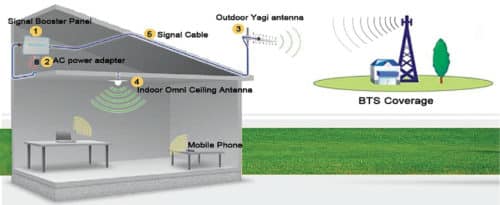Mobile signal booster are often used to overcome network issues inside office premises. Network unavailability might be caused due to the infrastructure or the location. With so many options of network boosters available in the market, it is difficult to make a choice.
This article enlists the main parameters to help you choose the best signal booster for your office.
How signal booster work
Cellphone signal booster improve the weak indoor tower reception on your mobile device by amplifying signals received from outside the building. A signal booster setup primarily consists of an external antenna, one or more inside antennae, and an amplifier—all connected with the help of cables.
Read more about Antennas here
The external antenna is positioned on a building’s terrace or outside a wall, while the other antenna is to be attached to the amplifier device indoors. The external antenna detects the network signal and passes it on to the amplifier through cables, where it is boosted. The amplified signal is forwarded to the internal antenna, which broadcasts it indoors. The signal flow route is reversed when you send some communication from your phone.
Broadly, signal boosters can be divided into two categories—one for building and office use, and the other for fixing on vehicles. In this article, we focus on antennae for small- and medium-sized office buildings.

What features should you look for?
When selecting a signal booster, the three important factors to consider are the frequency and the network supported (2G, 3G or 4G and the network provider), amplifier strength and antennae.
Read more about 1G to 4G communication here
Check network compatibility
Signal boosters support networks based on their frequencies. Network service providers tap into respective frequencies like 900MHz, 1800MHz, 2100MHz and so on to provide signals. Booster devices support these networks and their bands (2G, 3G or 4G) if they respond to the respective frequencies.
While a group of boosters in the market work with specific network providers, most of the devices support networks of almost all major carriers (Vodafone, Airtel, TATA and so on).
Today, majority of boosters supporting dual-band frequencies (up to 2100MHz) are compatible with 2G and 3G. However, the selected booster should preferably support 4G, which calls for a higher-band device. Getting the highest frequency of network coverage definitely provides the biggest advantage, but the cost goes up.

Go for a strong amplifier
The amplifier, as clear from the name, amplifies the signal received from the antenna. The preferable strength of the amplifier can be determined by two factors: Desired coverage area in the building and the strength of the original signal outside. Amplification is measured in decibels (dB), which denotes relative strengthening of the signal.
For a medium-size office space of around 280-370sq.m (3000-4000sq.ft), 60-65dB amplifier gain is a good choice. To get stronger amplification, go for amplifiers with higher decibel counts. Vendors also use another unit called decibel milliwatts (dBm) for signal output, which implies the actual amount of signal power available as output. The value of this parameter should be 20-23dBm.
Type of antennae
As mentioned earlier, the setup uses two types of antennae—one to be installed outside and the other to be used indoors. For office building applications, the key deciding factors for antennae include signal flow direction (omnidirectional or unidirectional) of the antenna and gain in dBi.
External antenna should be preferably omnidirectional, that is, it should support 360-degree to-and-fro signal flow of multiple carrier networks. The gain should be over 5dBi. Unidirectional antenna, called Yagi antenna, is good for individual or residential use in remote areas due to its superior reach to tower signals and single-carrier support.
Internal antenna should be omnidirectional dome type. These antennae transmit and receive signals in all directions. There is another category called panel antenna, which supports unidirectional flow of the transmitted signal. Select it if you have specific requirements only. Look for a gain of around 3dBi.

Price in the Indian market
In the Indian market, the average cost of cellular boosters ranges between ₹ 13,000 and ₹ 22,000 for 3G support and around ₹ 30,000 for 4G support. Some examples include:
1. Max mobile signal amplifier by Mobile Boosters India supports 3G coverage with up to 60dB gain and output power of 20dBm. It costs around ₹ 22,000.
2. AVA Systems offers Ledmate LM-604 3G cellphone booster, which supports all service providers with 60dB gain and 23dBm output. It costs around ₹ 21,000.
3. Mobile signal boosters by Ultramind Technologies India support all 4G-compatible providers (only Jio support needs to be verified) with 65dB gain. The device costs around ` 30,000.
The list of signal boosters available in the market is quite exhaustive. You may select one by thoroughly evaluating these based on your requirements, vendor reliability and the cost of the device.
Important points to remember
1. Signal boosters amplify the existing signal strength to provide coverage. If original signal is unavailable or much weaker than the minimum threshold, boosters will not work.
2. Affirm legal compliance as well as compatibility support from your network service provider.
3. Many vendors in the market claim that 4G is not supported currently due to frequency incompatibility. So verify frequency support with the device vendor as well as the service provider.
4. Determine the coaxial cable length based on the position planned for fixing the external antenna and indoor equipment. Keep in mind that transmission through cables causes a loss of signal strength by up to 5dB.
5. Affix the external antenna firmly as it will be exposed to different weather and wind conditions.
6. Ensure enough distance separation between external and internal antennae to avoid reverberations and unclarity.







1) How many indoor antennas we can cunnect in loop to a 23 bBm booster?
2) as mention booster covers 3000-4000 sq ft area. Foes it mean open area? If the antennas are placed in 1 cabin than will i get network in 2nd cabin just adjacent to 1st?
3) contact +91-9820862746